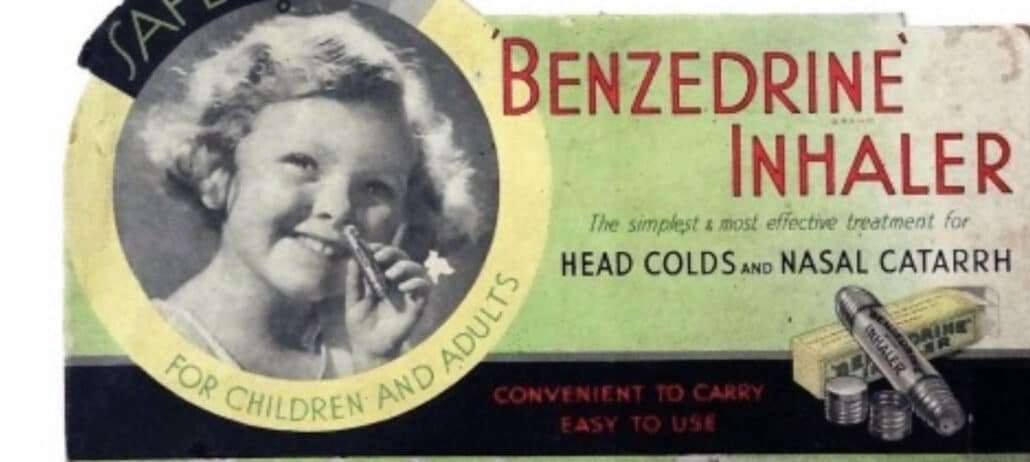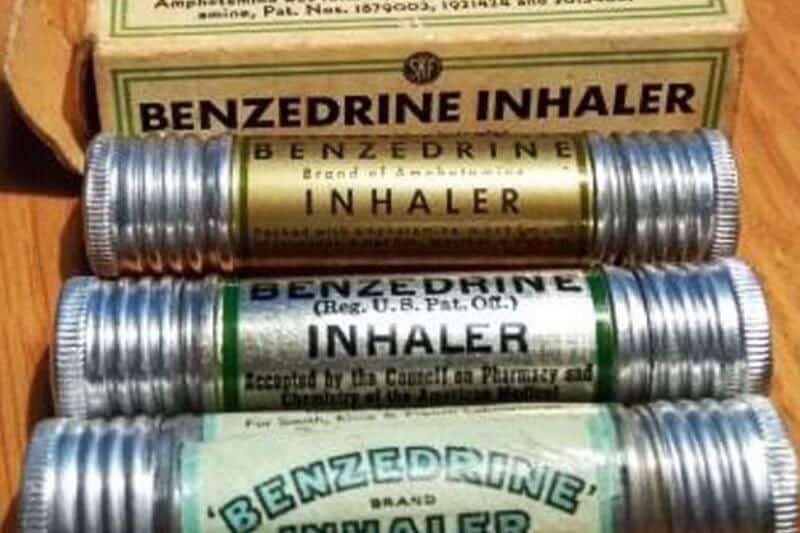A large proportion of the U.S. population has a problem with stimulants, both the prescription and street-level variety, according to several credible studies, one of which comes from the National Survey on Drug Use and Health. It revealed that over 10 million people misuse or outright abuse central nervous system stimulants.
For those unaware, stimulants stimulate the brain, which, in turn, speeds up numerous mental and physical processes. That explains the increased energy, attention, alertness, blood pressure, heart rate, and respiratory rate brought on by taking them. Prescription stimulants can, however, benefit people diagnosed with specific physical and mental health problems when taken as prescribed. But taking illegal stimulants and abusing legal ones can be a recipe for disaster.

Table of Contents
- 1 Benzedrine: The Storied History of Amphetamines
- 2 Why Benzedrine Was Billed as a Wonder Drug
- 3 How the U.S. Government Put an End to Benzedrine
- 4 Alternatives to Benzedrine That Are Still Available Today
- 5 The Difference Between Amphetamines and Methamphetamines
- 6 Stimulant Overdose Deaths in America
- 7 The Reality of Quitting Stimulants: What To Expect When Going Through Rehab
- 8 How Medication-Assisted Treatment Can Benefit People Trying To Quit Stimulants
- 9 Life After Stimulant Addiction
Benzedrine: The Storied History of Amphetamines
Long before the brand name amphetamine drugs most of us are familiar with, such as Adderall, Ritalin, Concerta, and Dexedrine, all of which physicians commonly prescribe as a weight loss aid or as a treatment for ADHD or narcolepsy, there was Benzedrine. Created by a Romanian chemist in 1887, Benzedrine was the first brand name for generic amphetamine. It was later rediscovered and patented by American scientist Gordon Alles in 1932. The active ingredients in Benzedrine, also known as “bennies,” included dextroamphetamine and levoamphetamine, both of which are amphetamine enantiomers. It was available in pill and inhaler form and initially used to treat asthma and nasal congestion.
Why Benzedrine Was Billed as a Wonder Drug
After securing a patent for Benzedrine, Gordon Alles teamed up with Smith, Kline, and French, a company known today as GlaxoSmithKline, to market the drug as a wonder drug in 1937. And this was easy to do. Before the Durham-Humphrey Amendment of 1951, which placed medications into prescription and over-the-counter (OTC) categories, manufacturers determined how to classify the drugs they sold to consumers. Alles, Smith, Kline, and French collectively chose to sell Benzedrine as an OTC drug. Along with becoming a go-to treatment for asthma and nasal congestion, bennies found commercial success with the following:
- A diet aid and mood-boosting drug for stay-at-home wives during the 1950s and 1960s
- As a medication to help keep soldiers alert and focused during World War II
- As a study aid for college students in the 1930s
How the U.S. Government Put an End to Benzedrine
The brand name Benzedrine, which had its heyday from the 1930s well into the 1960s, is no longer on the market. And there are several reasons why. In the early 1960s, several high-profile publications revealed that many people taking Benzedrine struggled with psychosis and other symptoms when they attempted to quit taking it. Many of the same publications also noted that people who were prescribed Benzedrine for weight loss were becoming addicted to and dying as a result of taking it.

These events prompted the U.S. government to step in, and it did so with Congress passing the Controlled Substances Act of 1970, the federal U.S. drug policy that regulates the manufacturing, importation, possession, usage, and distribution of certain medications. Stimulants, which included Benzedrine, were listed among those medications. For those curious, the other medications that became regulated with the passing of the Controlled Substances Act of 1970 included the following:
- Anabolic steroids
- Depressants
- Hallucinogens
- Narcotics
Alternatives to Benzedrine That Are Still Available Today
While the brand name Benzedrine is no longer on the market, the amphetamine-containing drug is still technically available. It is marketed and sold under brand names Adzenys ER, Adzenys XR ODT, Dyanavel XR, and Evekeo, all of which have been classified as amphetamines and fall under the umbrella of Schedule II drugs. These drugs are chemically the same as Adderall, Ritalin, and other amphetamine drugs that many people take to combat ADHD and narcolepsy. And they are just as addictive. They are also in many ways similar to street-level stimulants, such as cocaine and methamphetamines. That all said, the number of people abusing prescription and street-level stimulants is as much a problem today as it was in Bezedrine’s heyday, according to study data from the Centers for Disease Control and Prevention (CDC).
The Difference Between Amphetamines and Methamphetamines
Because many people start off abusing amphetamines and then move on to methamphetamines, we should take a moment to familiarize ourselves with how the two stimulants differ. Amphetamines are synthetic drugs that stimulate activity in the central nervous system by elevating levels of dopamine, norepinephrine, and serotonin in the brain. Along with increased focus and alertness, above-average levels of these neurotransmitters as a result of taking amphetamines can trigger intense feelings of pleasure and reward. But those feelings go away once the drug wears off. To combat withdrawal symptoms and to continue enjoying the euphoric effects of amphetamines, many people end up taking more as soon as they start to wear off. And this ultimately sets them up for addiction. Common signs of amphetamine abuse include the following:
- Compulsive or hypersexual behavior
- Dilated pupils and paleness
- Eating and sleeping less
- Elevated body temperature
- Extreme confidence and increased energy
- Feelings of exhilaration and excitement
- Frequent headaches
- High blood pressure
- Loss of social inhibitions
- Rapid breathing
- Sweating, dry mouth, and diarrhea
Although methamphetamines are also stimulants, they are an entirely different kind of stimulant. Commonly referred to as meth, crank, or ice, methamphetamines are illicit synthetic stimulants comprising amphetamines mixed with drain cleaner, battery acid, paint thinner, lighter fluid, and other automotive and household substances. When someone snorts, injects, or smokes methamphetamines, they experience an immediate and intense euphoric high due to how the drug affects their central nervous system. Methamphetamines can also cause permanent damage to the body, especially to the brain, heart, kidneys, and lungs.
After the effects of illicit methamphetamines wear off, most people struggle with anxiety, cravings, confusion, lethargy, and insomnia. To combat these and other withdrawal symptoms, many people will seek out and take more of the drug, often in higher quantities, which ends up opening the door to addiction. Signs of methamphetamine abuse are generally the same as those associated with amphetamine abuse.
Stimulant Overdose Deaths in America
While Benzedrine is long gone, many people are overdosing on other amphetamine drugs of today. The same applies to illegal stimulants, such as cocaine and methamphetamines. In a study published by the CDC, researchers revealed that overdose deaths from stimulants have been on the rise since 2010. Researchers estimate that close to 33,000 people in the U.S. died from an overdose involving stimulants in 2021, an increase of roughly 37% compared to 2020. But there is some good news. With more and more people getting the help they need to get off these highly addictive drugs, overdose deaths are now slowly coming down.
The Reality of Quitting Stimulants: What To Expect When Going Through Rehab
The first step in recovering from an addiction to stimulants is making the conscious decision to quit. From there, it’s a matter of starting an inpatient or outpatient addiction recovery program and following up with counseling from a licensed therapist. But none of this is easy. That is in part due to the withdrawal symptoms associated with the abrupt cessation of these kinds of drugs, many of which start within a few hours after someone consumes their final dose. When most people quit taking stimulants and go to rehab, they experience the following symptoms:
- Nausea
- Fever
- Irregular heartbeat
- Sweating
- Headaches
- Increased breathing rate
- Seizures
- Cardiac arrest
- Dizziness
- Aggression
- Anxiety
- Psychotic behavior
While the physical discomfort of stimulant withdrawal usually peaks early on, the psychological effects, like depression, anxiety, and cravings, can persist for several weeks or months.
How Medication-Assisted Treatment Can Benefit People Trying To Quit Stimulants
The human body will naturally try to rid itself of stimulants and related toxins once someone stops taking them. This process is called detox, and it can be the catalyst for the onslaught of numerous unpleasant withdrawal symptoms. In some cases, symptoms typical of stimulant cessation are so severe that some people give up trying to quit and return to using again. For this reason, many rehab facilities specializing in stimulant addiction recovery offer medication-assisted treatment (MAT).
MAT refers to the use of prescription medications, along with counseling and behavioral therapies, to treat stimulant use disorders. While there are no standardized FDA-approved medications to help ease withdrawal symptoms brought on by abrupt stimulant cessation per se, Prozac and naltrexone are considered the two go-to medications by rehabs in Long Island and throughout most of New York and the Tri-State area.
Life After Stimulant Addiction
Even after weathering the storm of stimulant-related withdrawal symptoms brought on by detox, attending addiction education courses, and completing counseling sessions with a licensed therapist to overcome the psychological challenges that come with quitting stimulants, some people are still not out of the proverbial woods. Cognizant of this, many rehabs offer referrals to support groups after someone completes a stimulant addiction recovery program. Narcotics Anonymous (NA) is the one they refer people to the most. While attending NA support group meetings, individuals learn how to cope with cravings, triggers, and other challenges that could lead to them using again. They also connect and make friends with other members who are just as committed to turning their lives around.
Abusing stimulants of any kind can quickly turn one’s life upside down. Thankfully, there are addiction recovery programs that can help people put stimulant addiction behind them. To learn more about breaking this particular cycle of addiction, consider speaking with one of our Long Island Interventions specialists today.
Published on: 2024-08-25
Updated on: 2025-06-05

